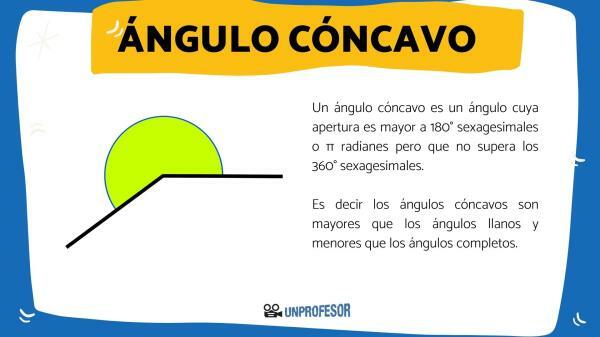What is a CONCAVE angle

A concave angle is an angle that has an opening greater than 180°. sexagesimals or π radians, but not exceeding 360° sexagesimals. In unProfesor we tell you about it and we offer you solved exercises.
In a new lesson from a Teacher we will study what is a concave angle with examples. First we are going to review what an angle is and what its types are. Then we will see in detail what a concave angle is, its characteristics and some examples. We will end with some exercises on the theme worked on.
A concave angle is an angle whose opening is greater than 180°. sexagesimals or π radians but not exceeding 360° sexagesimals. That is, the concave angles are greater than the flat angles and less than the complete angles.
The word concave refers to the characteristic that a surface has that has a greater sinking in its central part than at the ends.
In an everyday scenario, we can see several examples of concavity, such as a bowl of soup or deep plate, a well being dug for construction, a skateboard skating rink, a roller coaster, etc
In the classification of angles we find according to their measure or opening to convex and concave angles.
While convex angles measure between 0° and 180° sexagesimals, concave angles measure between 180° and 360° sexagesimal.
When a convex angle is made, the angle that forms on the outside of the rays is a concave angle, and because of this it is also known as a reflex angle.

Now that we know what a concave angle is, let's go over some math basics.
Let's start at the beginning: what is an angle? An angle is the portion or part of the plane that is included between two lines or half lines that have an origin or point in common.
When we talk about angle, in geometry we refer to that part of the plane between the union of two rays that start from the same vertex, point or origin, and that measures the opening between those lines or rays.
Angles can be measured in degrees sexagesimals and radians:
- For the measure in sexagesimal degrees, we know that 1 degree equals 60 minutes, and that 1 minute equals 60 seconds.
- While for the measure in radians, we know that a complete turn of 360° sexagesimals is equivalent to 2π and 180° sexagesimals is equivalent to π.
Here is a review of the different types of angles.

Here we leave you concave angle exercises with solutions so you can practice at home.
1) If a concave angle measures 230°, its exterior convex will measure...
- 100°
- 130°
- 140°
2) Within the following angles, there is one that is not concave, and it is….
- 278°
- 179°
- 320°
3) Angle 78° is convex, its exterior concave measures….
- 282°
- 322°
- 272°
4) The following angles are concave or convex….
- 225°
- 125°
- 340°
- 275°
- 98°
Solutions
- If a concave angle measures 230°, its exterior convex will measure 130°
- Within the following angles, there is one that is not concave, and it is 179°
- Angle 78° is convex, its outer concave measures 282°
- The following angles are concave or convex….
- 225° concave
- 125° convex
- 340° concave
- 275° concave
- 98° convex
If you liked this lesson from a Teacher, don't forget to share it with your classmates. You can keep browsing the web to find more content like this.



